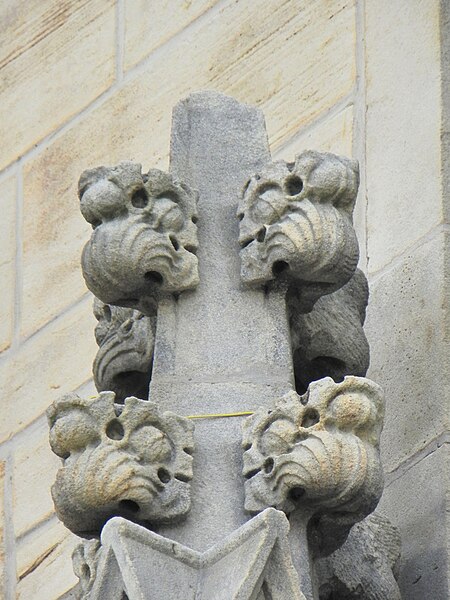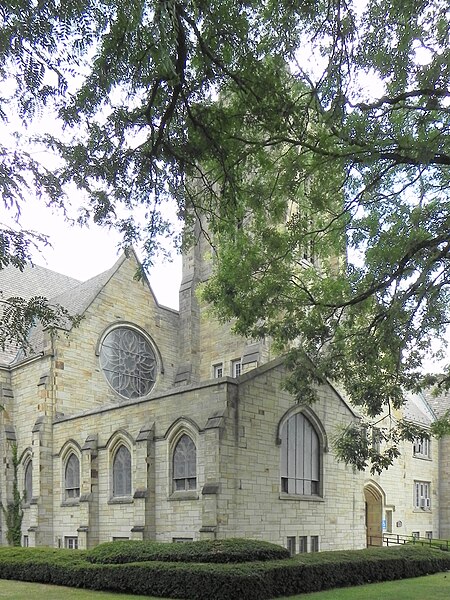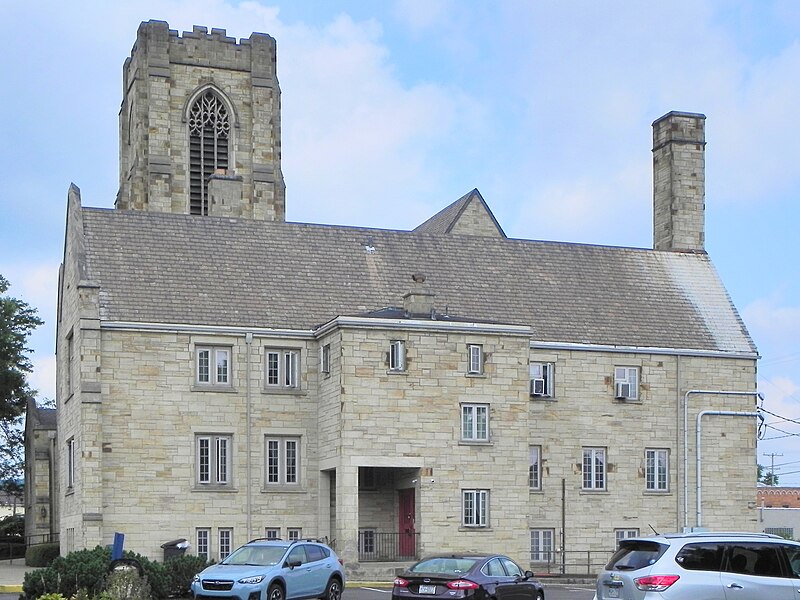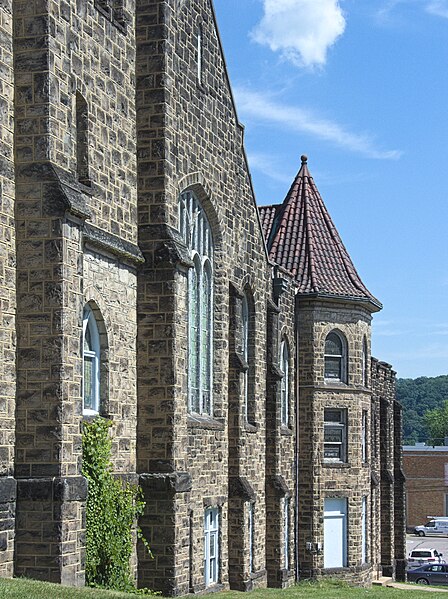
A simple little Gothic church; it now belongs to Mancini’s bakery across Mancini Way.


A simple little Gothic church; it now belongs to Mancini’s bakery across Mancini Way.


The most striking feature (in two senses of the word “striking”) of this church is the great clock tower, which gives time to the whole village. In fact, the borough took over responsibility for maintaining the clock, as the church tells us in its page of Village Clock Tower Facts. The tower was finished in 1884, and in 1996 a thorough rebuilding was finished that included a new electronic clock to replace the replacement clock that had replaced the original clock many decades previously.





This grand Gothic complex was one of two Presbyterian churches that stood on opposite corners of the same intersection. The other one was the First United Presbyterian (old Pa Pitt will probably never tire of that joke, which the Presbyterians hand to him on a silver platter). Eventually the United Presbyterian congregation united with this one, which is now known as the Presbyterian Church of Coraopolis, though it seems to have used the name Coraopolis Presbyterian relatively recently, when it picked the domain name for its Web site.
The current lavish building was put up in 1929, as we learn from a postcard on the church’s history page, at a cost of $315,000 including furnishings.
















This is one of the few remaining churches designed by Joseph W. Kerr, who was one of our top architects in the middle 1800s (he also designed the Shields Chapel nearby in Edgeworth). It opened in 1861, at the beginning of the Civil War.
In Father Pitt’s opinion, Mr. Kerr had good taste. Both this church and the Shields Chapel belong to the middle nineteenth century, but they were never embarrassingly out of date; to the last gasp of the Gothic style in America a hundred years later, an architect familiar with the idiom would have found this a pleasing and successful design.

It is fortunate that the congregation has the money to keep the glorious steeple in excellent shape…

…right up to the iron pinnacle at the top.






William P. Hutchins was the architect of this church, built in 1924. It takes its inspiration from ancient Roman basilicas, with a light overlay of Art Nouveau. Most architectural historians would probably just say “Romanesque” and leave it at that, but it is a more interesting building when we recognize its ancient sources.







Here is a fine example of the last gasp of Gothic architecture in America. This church was built as late as 1951 in a style that would have seemed reasonably conservative twenty years earlier. The building has passed into the hands of the Immanuel Orthodox Presbyterian congregation, and members were spiffing up the grounds while old Pa Pitt was taking these pictures.


The west-front entrance is very similar to what William P. Hutchins did more than two decades earlier at St. Francis Xavier Church in Brighton Heights; perhaps they were both inspired by the same historical example.







Around the corner, behind the church, is a Sunday-school building that dates from 1928 in a style we might call Educational Gothic.




Now the Coraopolis United Methodist Church. The father-and-son team of T. B. and Lawrence Wolfe, part of a century-long dynasty of Wolfes in Pittsburgh architecture, designed this church, built in 1924.

Our friend Dr. Boli had opinions about this picture.



The building this one replaced is also still standing—a typical late-1800s Pittsburgh Rundbogenstil church, and one with the sanctuary upstairs if you come in by the front door. It was a short block away, and it is still in use as a church, now Coraopolis Abundant Life Ministries.

Cameras: Kodak EasyShare Z1285; Canon PowerShot SX150 IS; Kodak EasyShare Z981.

Two grand Presbyterian churches stand at the two ends of Uptown Mount Lebanon. But they are different kinds of Presbyterians. The one to the north was the United Presbyterian church, but it has now become Evangelical Presbyterian. This one is now Presbyterian Church (USA).
“In these days of mergers,” James Macqueen (himself one of our notable architects) wrote in the Charette in 1930, “one wonders why theological differences stood in the way of unity, and that these Presbyterians did not build one great building in this community instead of two with their attendant extra overhead involved. However, both of these two churches are worthy of a visit, as they show the great advance that has been made in Church work during the past few years…”
Southminster was designed by Thomas Pringle and built in 1928.






These quatrefoil ornaments at the top of the tower can be properly appreciated with a very long lens.


The office and education wing is done in a complementary Jacobean style. The arcade makes both a visual and a practical link to the main church.


Appropriately for a building dedicated to Christian education, the Reformation slogan VDMA—Verbum Domini Manet in Aeternum (“The word of God endureth for ever,” 1 Peter 1:25)—is engraved in an open book.
We have more pictures of Southminster Presbyterian from a couple of years ago.

This is a fine building in a good neighborhood, and you could buy it right now and move in. You might have to spend another million or so fixing it up, but the structure is sound and the interior of the sanctuary, from what we can see on that real-estate site, is intact in the most important details. It does need work, but the best parts of the interior are still there. If you are a congregation looking for a sanctuary, you can put your teenage members to work. That’s why you have youth groups, after all.
The church was built in 1915; the architect was Thomas Hannah, a big deal in Pittsburgh architecture. Comparing the church today to an old postcard, we can see that nothing has changed on the outside.

Well, one thing has changed. The church accumulated decades of industrial grime, turning it into one of our splendid black-stone churches, and the blackness, though fading, has not been cleaned off. Father Pitt hopes the church will pass into the hands of someone who appreciates it in its current sooty grandeur.
The other thing that is different is the long-gone building behind the church in the postcard. It was almost certainly the older sanctuary, probably kept standing as a social hall. It has been gone for years now.

The style of the church is what we might call Picksburgh Perpendicular, the common adaptation of Perpendicular Gothic to the more squarish auditorium-like form of Protestant churches that emphasized preaching over liturgy. Old Pa Pitt will admit that he does not like the stubby secondary tower on the left. It is probably very useful in providing space for a stairwell, but the two towers are too widely separated, as if they are not on speaking terms. The emphatic corner tower is the star of the show, and the other tower seems to be making an ineffectual attempt to upstage it. In spite of that quibble, though, this is a beautiful building that deserves appreciative owners.

